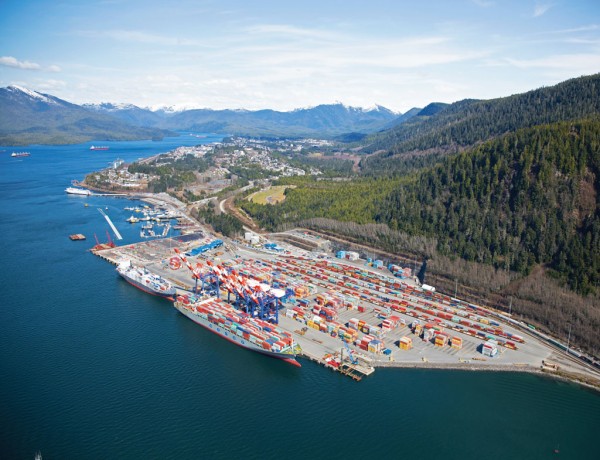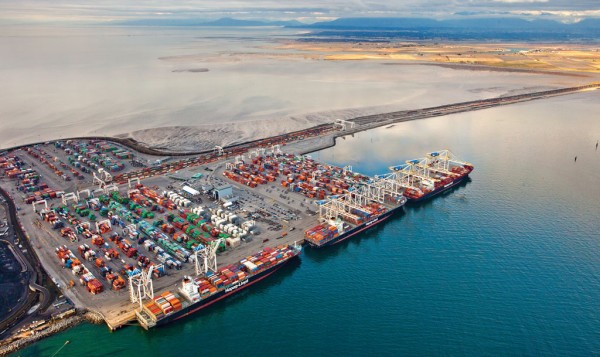For Canadian ports on the Pacific Coast, spring did not come soon enough, though its arrival was certainly welcomed. A particularly harsh winter throughout Western Canada notably affected railway operations which in turn provoked serious congestion problems for shippers at the key British Columbia gateways of Vancouver and Prince Rupert already coping with growth management challenges.
For the Port of Prince Rupert in northern British Columbia, latest developments have brought good news, with the recently-expanded Fairview Container Terminal operated by DP World restoring fluidity to its targeted 2.5-day dwell times in the wake of several months of congestion linked to weather-related rail service issues and double-digit growth in volume. Early in the winter, dwell times had reached as many as six days.
With the first quarter container numbers showing a 28% increase, thereby maintaining the strong momentum of last year, Stevenson predicted that “assuming a sustained trend and the continuing confidence of our customers, we are on track for another record year and should easily exceed one million TEU in 2018.”
Last year, the port’s container throughput soared by 26% to 926,540 TEU.

The expansion last fall of the Fairview facility increased its capacity from 850,000 TEU to 1.35 million TEU.
“We are taking a pragmatic approach with DP World on the next phase of expansion,” Stevenson said, adding that it could involve another half-million TEU – taking into account market demands and the essential need to maintain fluid operations.
The Fairview Container Terminal is now Canada’s second largest gateway for intermodal trade. Additional terminal capacity has been fully realized with the deployment of rubber tired gantry (RTG) cranes in the terminal rail yard, increasing outbound rail capacity from 30,000 to 40,000 feet per day. That’s the equivalent of four 10,000-ft freight trains daily.
“Over the past decade,” Stevenson noted, “imports have really focused on the ICI business – Inland Point Intermodal where containers are moving intact right onto rail for inland destinations. The increased trucking, we are seeing is all about exports finding their way into Prince Rupert.”
In addition to nearly 200 longshore positions added in Prince Rupert in 2017, ILWU 505 is in the process of recruiting an additional 200 longshoremen this month to ensure the local workforce is sufficient.
CN has increased intermodal rail equipment supply and acquired additional locomotives for the Prince Rupert rail corridor, as part of a $3.2 billion capital investment plan for 2018 to improve network efficiency. “Our collaborative approach to strategic planning and responding to customer demand continues to be one of the greatest strengths of the Prince Rupert model,” said Stevenson. “The recent challenges we experienced are regrettable. However, the situation demonstrated our collective commitment to our customers and to the sustained fluidity of our operations.”
Last year, Prince Rupert recorded the largest cargo increase of all Canadian ports, with total volume rising by 28% to 24.3 million metric tons. This spike was led by double-digit increases in intermodal container business and dry bulk. Terminal expansion and new logistics services played key roles.
Ridley Terminal shipped 17.6 million tons of metallurgical coal, a 90% increase over 2016. Westview Wood Pellet Terminal exported 1.1 million tons for biofuel production, representing a 22% increase from the previous year.
Exports from the grain terminal were down moderately due to lower wheat shipments, but it still handled more than 5 million tons of grain and specialty products for the fifth consecutive year.
According to Bud Smith, chairman of the Prince Rupert Port Authority, Prince Rupert “remains well-positioned to accommodate growth of Canadian trade in the Asia-Pacific region, and we continue to advance expansion that will see us become Canada’s second-largest port by volume in the next decade.”
This prediction suggests that Prince Rupert will overtake Montreal in the medium term as Canada’s second largest port after Vancouver.
Port of Vancouver
Meanwhile, recent reports show that rail delays that have hit shippers hard in Western Canada and the U.S. Midwest for several months have not yet been completely eliminated at the Port of Vancouver. There has, nonetheless, been an improvement in dwell times from previous peaks above five days.
Overall cargo volume through the Port of Vancouver in 2017 reached a record high of 142.1 million metric tons, up five per cent from 2016. Sectors experiencing strong growth include containers and bulk grain, both of which hit new summits in 2017.
“The record year for cargo movement and healthy growth across the port reflects the strength of the Canadian economy in 2017, as well as the Port of Vancouver’s ability to accommodate the most diversified range of cargo of any port in North America,” said Robin Silvester, president and chief executive officer at the Vancouver Fraser Port Authority. Overall container traffic saw a significant increase of 11% over 2016 to reach a record of 3.3 million TEU, with loaded imports up by 11%. Volumes were driven by a global upswing in economic activity, which boosted Canadian export sales and overall strength in the transpacific container market.

A federal agency recently threw cold water on well-advanced plans to establish a big new terminal at the Port of Vancouver’s Roberts Bank
“Year over year we continue to see an increase in the global demand for Canadian products shipped in containers and Canadian demand for consumer and manufacturing goods from Asia,” continued Silvester. “To meet future demand, we are taking steps to ensure the Port of Vancouver is ready to handle growing container volumes through Canada’s West Coast. A number of investments in infrastructure are already underway in the port to build container capacity.”
A key infrastructure priority is the Terminal 2 project for a C$2 billion, three-berth second container terminal at Roberts Bank that would provide an additional 2.4 million TEU capacity to meet anticipated demand and remain competitive with U.S. ports accommodating the larger ships now being deployed in the transpacific trades. The expanded terminal would be built about four miles from the shoreline at the western end of the existing causeway, encompassing an area of 270 acres that would include a container storage yard, rail intermodal yards and improved road access.
It is estimated that even with current and proposed improvements to existing infrastructure, additional capacity will be needed by the early to mid 2020s. The project’s backers would like construction to begin sometime this year.
But environmental lobbies have been escalating their opposition. And some analysts have described as “a potential death blow” a development which occurred this past February – the serious concern expressed by a federal agency over the project’s impact on hundreds of thousands of sandpipers that migrate annually to the South Delta. The stern warning was delivered by Environment and Climate Change Canada (ECCC) to the Canadian Environmental Assessment Agency which still has not given the required regulatory approval. The ECCC challenges the project’s proposed mitigating measures. Public hearings are expected soon – with uncertainty continuing to surround the final outcome of the whole complex process.





